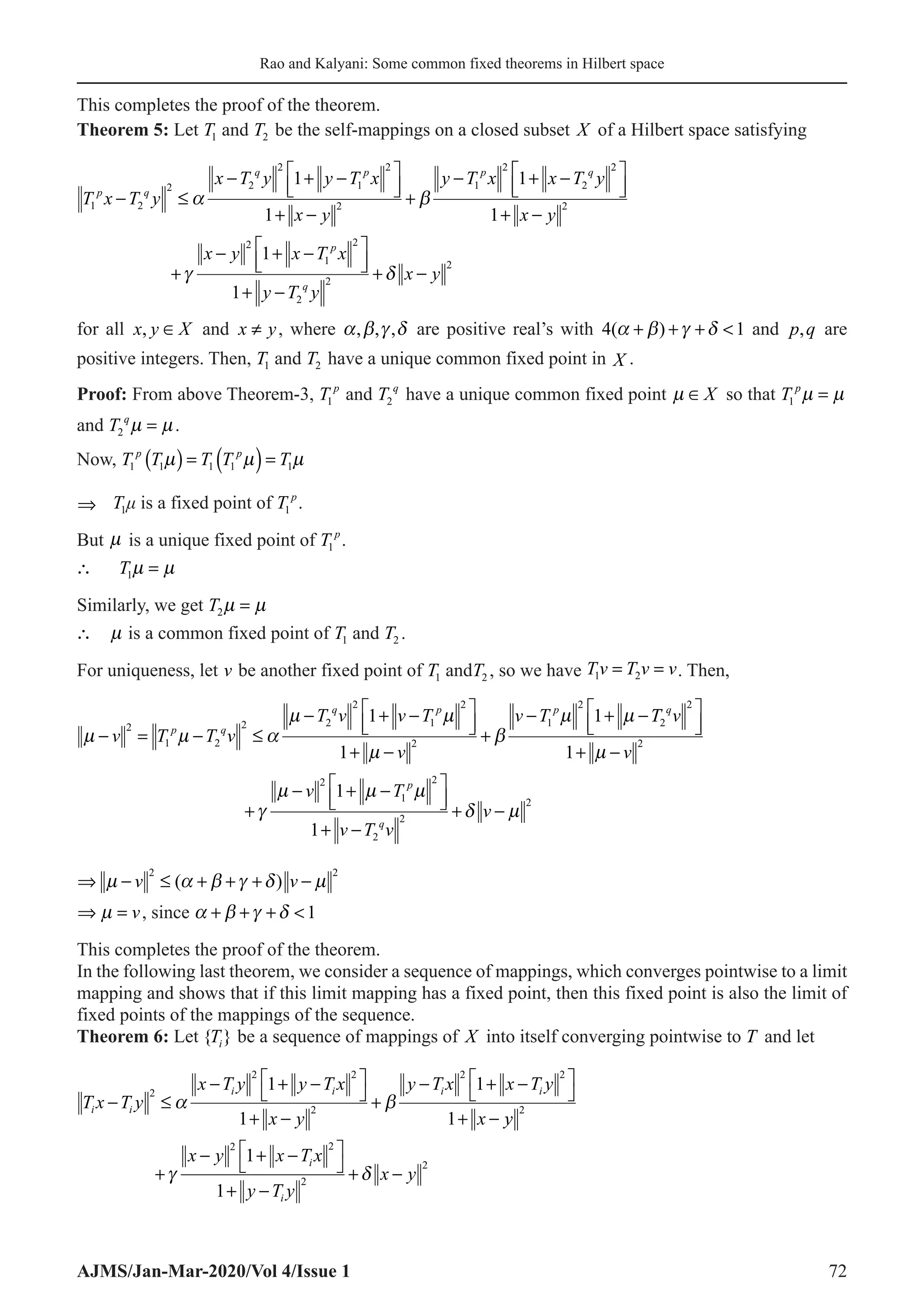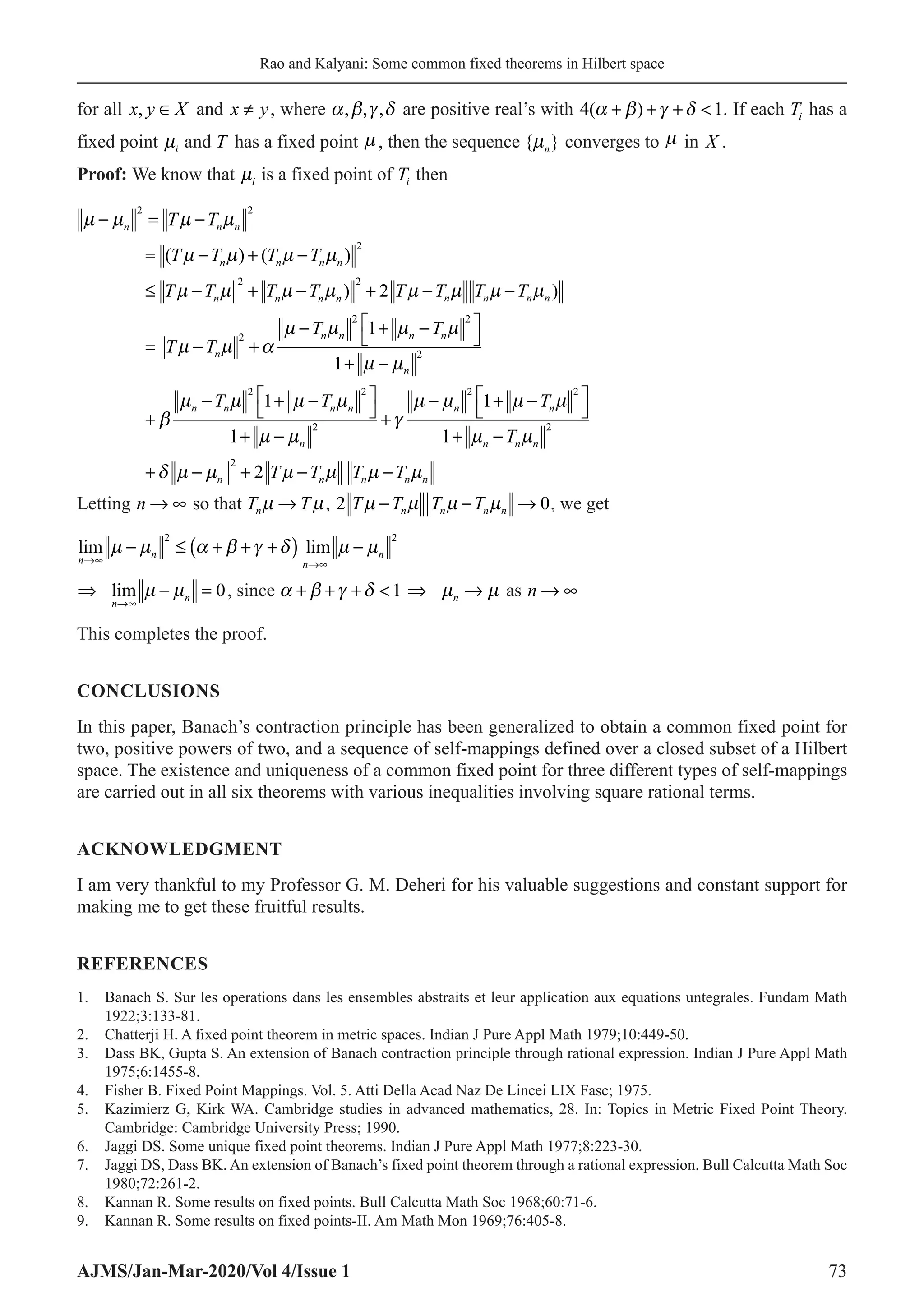The document presents three theorems regarding common fixed point theorems in Hilbert spaces:
1. The first theorem proves that if two self-mappings T1 and T2 of a closed subset X of a Hilbert space satisfy a certain contraction condition involving rational terms, then T1 and T2 have a unique common fixed point in X.
2. The second theorem extends the first by proving the result for the mappings T1p and T2q where p and q are positive integers.
3. The third theorem considers a sequence of mappings {Ti} on a closed subset of a Hilbert space converging to a limit mapping T, and proves if T has a fixed point, then it is the limit of
![www.ajms.com 66
RESEARCH ARTICLE
Some Results on Common Fixed Point Theorems in Hilbert Space
N. Seshagiri Rao1
, K. Kalyani2
1
Department of Applied Mathematics, School of Applied Natural Science, Adama Science and Technology
University, Post Box No. 1888, Adama, Ethiopia, 2
Department of Science and Humanities, Vignan’s Foundation
for Science, Technology and Research, Guntur, Andhra Pradesh, India
Received: 25-12-2019; Revised: 17-01-2020; Accepted: 31-01-2020
ABSTRACT
This article provides the existence and uniqueness of a common fixed point for a pair of self-mappings,
positive integers powers of a pair, and a sequence of self-mappings over a closed subset of a Hilbert
space satisfying various contraction conditions involving rational expressions.
Key words: Hilbert space, closed subset, Cauchy sequence, completeness.
Mathematics Subject Classification: 40A05, 47H10, 54H25.
INTRODUCTION
From the well-known Banach’s contraction principle, every contraction mapping of a complete metric
space into itself has a unique fixed point. This celebrated principle has played an important role in the
development of different results related to fixed points and approximation theory. Later, it has been
generalized by many authors[1-14]
in metric space by involving either ordinary or rational terms in the
inequalities presented there. Again, these results were extended by other or the same researchers[15-21]
in
different spaces. Thereafter, these results were again extended/developed for getting a unique fixed point
to a pair of continuous self/different mappings[22-26]
or more than two or a sequence of mappings, which
may be continues or non-continues or imposing some weaker conditions on the mappings in the same or
different spaces.[27-33]
As already stated, many authors have generalized Banach’s contraction principle through rational
expressions in different spaces such as metric, convex Banach’s space, and normed spaces. But still
here are some extensions/generalizations of this principle paying an attention in terms of taking rational
expression in Hilbert spaces.
In this paper, we have considered a pair of self-mappings T1
and T2
of a closed subset X of a Hilbert
space, satisfying certain rational inequalities and obtained a unique fixed point for both T1
and T2
. We
have developed this result to the pair T1
p
and T2
q
where p and q are some positive integers and then also
further extended the same results to a sequence of mappings. In each of the above three cases, we have
obtained common fixed point in X. These results are generalizations of Koparde and Waghmode[29]
in
Hilbert space.
MAIN RESULTS
Theorem 1: Let T1
and T2
be two self-mappings of a closed subset X of a Hilbert space satisfying the
inequality
Address for correspondence:
N. Seshagiri Rao
E-mail: seshu.namana@gmail.com
ISSN 2581-3463](https://image.slidesharecdn.com/5ajms23119ra-221021051816-834a3bf4/75/5_AJMS_231_19_RA-pdf-1-2048.jpg)







